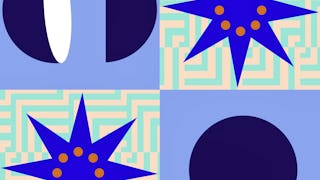This course is an introduction to composition specifically as it is used in the moving image. There are four modules: Cinematic Thinking, which will serve as an overview of cinematic history, vocabulary, and alternative approaches to filmmaking, Choreography for Camera, a dive into the rules of composition and camera movement, Light Writing, which will explore different kinds of lighting, and Composing, in which all that we’ve learned will be combined and broader aspects of filmmaking such as sound and editing will be introduced.


The Art of Filmmaking: Composition and Moving Image
本课程是 The Art of Filmmaking 专项课程 的一部分
3,945 人已注册
包含在 中
您将学到什么
how to describe shot and sequence design in both formal and conceptual terms
visual strategies for composition and movement in filmmaking
the use of both natural and studio lighting in filmmaking
how moving images can be altered using visual effects in the post-production process
您将获得的技能
要了解的详细信息
了解顶级公司的员工如何掌握热门技能

积累特定领域的专业知识
- 向行业专家学习新概念
- 获得对主题或工具的基础理解
- 通过实践项目培养工作相关技能
- 获得可共享的职业证书

该课程共有5个模块
涵盖的内容
1个视频4篇阅读材料1个讨论话题
In this module you will start thinking cinematically by observing the world around you, learning some filmmaking vocabulary, and getting an introduction to the science and history of filmmaking and how it relates to photography and other visual art forms. You will also learn about experimental and personal approaches to using a camera for self expression.
涵盖的内容
7个视频9篇阅读材料4个作业1次同伴评审2个讨论话题
In this module we will describe the basic “rules” of composition and framing shots in filmmaking. We will compare lenses and optics, and explore camera movement. By the end of this module you will create dynamic images through the camera lens.
涵盖的内容
11个视频6篇阅读材料3个作业1次同伴评审2个讨论话题
Photography literally means light writing, so this module is all about light. By the end of this module you will be able to understand how cameras “see” and “capture” light, identify the importance of exposure, contrast, highlights, shadows and color in your images, and gain an understanding of how to use both natural and studio/artificial lighting.
涵盖的内容
10个视频7篇阅读材料4个作业1次同伴评审2个讨论话题
By the end of this final module of the course you will understand how all elements of filmmaking combine together to create a cinematic experience. You will be able to plan a shoot for the edit, identify the importance of pre-production and production in creating visual effects, and transform a sequence of shots into an expressive short video project. You will also strengthen your ability to give and accept critiques through peer review.
涵盖的内容
11个视频5篇阅读材料3个作业1次同伴评审3个讨论话题
获得职业证书
将此证书添加到您的 LinkedIn 个人资料、简历或履历中。在社交媒体和绩效考核中分享。
位教师

从 Music and Art 浏览更多内容

California Institute of the Arts

California Institute of the Arts
人们为什么选择 Coursera 来帮助自己实现职业发展




常见问题
CalArtians can earn a certificate by completing all of the content in this course and the specialization at no additional cost when they join through the Coursera for CalArts program and use their CalArts email address when registering for a Coursera account.
To access the course materials, assignments and to earn a Certificate, you will need to purchase the Certificate experience when you enroll in a course. You can try a Free Trial instead, or apply for Financial Aid. The course may offer 'Full Course, No Certificate' instead. This option lets you see all course materials, submit required assessments, and get a final grade. This also means that you will not be able to purchase a Certificate experience.
When you enroll in the course, you get access to all of the courses in the Specialization, and you earn a certificate when you complete the work. Your electronic Certificate will be added to your Accomplishments page - from there, you can print your Certificate or add it to your LinkedIn profile.
更多问题
提供助学金,
¹ 本课程的部分作业采用 AI 评分。对于这些作业,将根据 Coursera 隐私声明使用您的数据。




